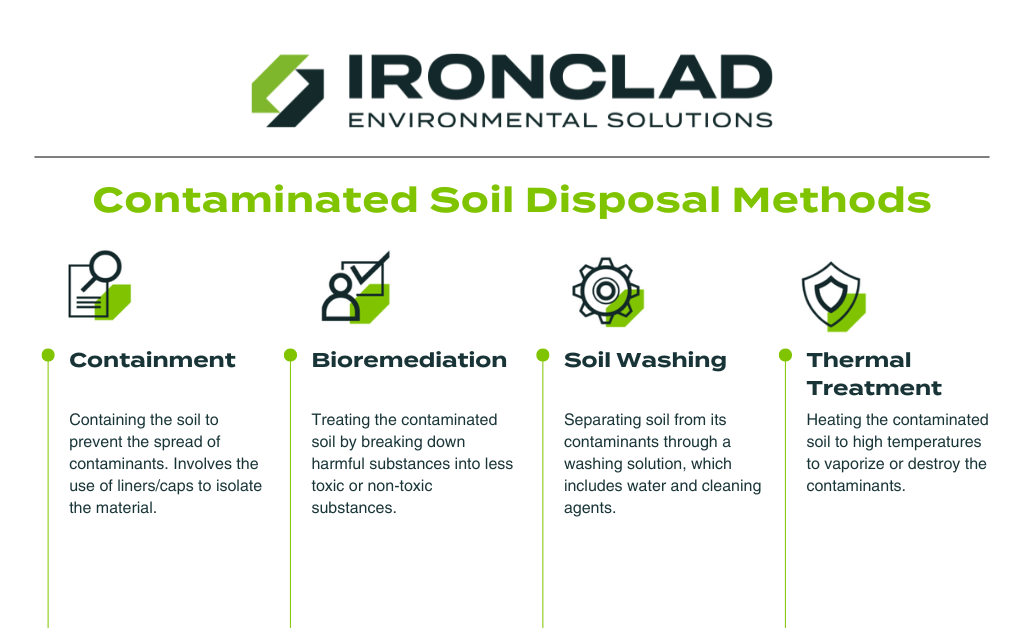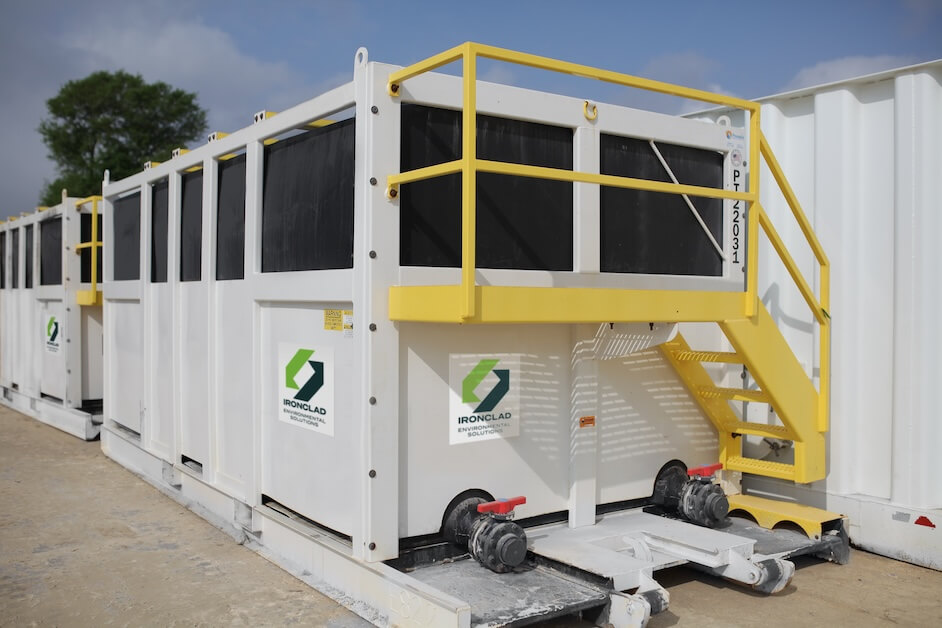Tips for Disposing of Contaminated Soil
The disposal of contaminated soil is not just a regulatory requirement; it's an important step in protecting environmental and human health. Proper disposal ensures that harmful chemicals and pollutants are contained and treated, preventing them from damaging valuable water sources and ecosystems.
What Exactly is Contaminated Soil?
Soil is contaminated when it contains substances that are potentially harmful to the environment and human health. This pollution can come from a variety of hazardous chemicals and pollutants, including but not limited to, heavy metals like lead and mercury, polycyclic aromatic hydrocarbons, vinyl chloride, pesticides, petroleum products, asbestos, and industrial solvents.
This contamination often comes from various sources, such as:
- Industrial waste from manufacturing processes
- Wood Treating Facilities
- Accidental spills during petroleum or chemical product transport
- Runoff from agricultural sites
- Leaks from underground storage tanks
- Petroleum-contaminated soil
- Illegal dumping of hazardous materials
How to Identify Soil Contamination
Identifying contaminated media is crucial for effective management and remediation. Signs of potential soil contamination include unusual odors, discoloration, soil erosion, changes in soil texture, or a sudden decline in the growth of vegetation on the site. Historical analysis of land use can also provide significant insights -- land previously used for industrial activities, waste dumps, or agricultural fields that were treated with heavy pesticides is more likely to be contaminated.
Analytical testing and soil sampling are required to accurately determine soil contamination. The purpose of these tests is to examine the soil sample, measure contaminant concentrations, and assess their spread within a site, providing detailed insights into the types and levels of pollutants present.
These analyses help companies plan the appropriate remediation strategy to effectively target and eliminate the environmental threat.
EPA Regulations for Soil Disposal
The Environmental Protection Agency (EPA) provides information about the Hazardous Waste Determination process, which is designed to ensure environmental safety when disposing of contaminated soil.
According to the EPA, the management of waste materials must comply with the Resource Conservation and Recovery Act (RCRA), which provides the framework for proper waste management practices.
Classifying Solid Waste
This EPA guidance document, states that solid waste is "any garbage or refuse, sludge from a wastewater treatment plant, water supply treatment plant, or air pollution control facility and other discarded material, resulting from industrial, commercial, mining, and agricultural operations, and from community activities."
The proper classification and disposal of contaminated soil not only comply with legal requirements but also prevent further degradation of the environment. It's extremely important for companies dealing with contaminated soil to be familiar with these regulations and ensure compliance through rigorous testing and accurate classification.
Best Practices for Contaminated Soil Disposal
Effective disposal is crucial to mitigating environmental risks, and various methods can be used depending on the type and extent of contamination. Each method involves specific protocols to ensure environmental safety and compliance with regulations.

Soil Disposal Methods
- Containment: Containing the soil in a barrier to prevent the spread of contaminants. This method is used when removal is not feasible and typically involves the use of liners and caps to isolate the soil and prevent it from affecting nearby areas.
- Bioremediation: Treating the contaminated soil by breaking down hazardous substances into less toxic or non-toxic substances. This method is effective when mitigating organic pollutants like petroleum hydrocarbons, but it can take longer than other disposal options.
- Soil Washing: Separating soil from its contaminants through the use of a washing solution, which can include water and cleaning agents. The separated pollutants are then treated or disposed of.
- Thermal Treatment: Heating soil to high temperatures to vaporize and/or destroy the contaminants. This is particularly effective for semi-volatile and volatile organic compounds.
Best Practices for Excavation, Transportation, and Disposal
The EPA provides a guideline of best practices for excavation, transportation, and disposal of soil to minimize environmental impact.
- Excavation: Ensure that excavation minimizes the disturbance of surrounding areas on the site. Plan the excavation to prevent any runoff of contaminated materials into clean areas of the site.
- Transportation: This requires careful planning to prevent accidental releases of the excavated soil. Use roll-off boxes, which are designed to handle these types of soil contaminants. Make sure these containers are sealed and labeled according to regulatory standards.
- Disposal: Choose a disposal method that aligns with the type of contamination and complies with local/federal regulations. Work with a company like Ironclad Environmental that can assist you with the containment and transportation of the contaminated soil, and make sure you document all activities for compliance purposes.
Following these best practices not only ensures compliance with environmental regulations but also minimizes the impact of contaminated soil on the environment. By carefully managing each step of the process, companies can effectively reduce the potential for environmental harm and promote sustainability in soil management.
Equipment Used for Disposing of Contaminated Soil
Having the right equipment is necessary for safely handling contaminated soil and ensuring that all operations align with industry regulations.
This is where roll-off boxes come into play, aiding in the containment, transport, and disposal of contaminated soil. These roll-off containers are particularly effective for containing solid waste and separating liquids from solids, and they can securely contain a wide range of contaminants, preventing any leakage during transportation to the final disposal facility. .
Advantages of Using Roll-Off Boxes
Roll-off boxes offer various benefits when dealing with contaminated soil:
- Reliable Equipment: This equipment undergoes a rigorous inspection process, ensuring top performance and zero leaks during transport until disposal.
- Compliance: They comply with strict environmental regulations, ensuring the safe containment of materials.
- Environmental Protection: Secure containment prevents the spread of pollutants, improving environmental quality.

Ironclad Environmental: Experts in Non-Hazardous and Hazardous Waste Transportation
At Ironclad Environmental, we are leaders in specialty containment solutions. Part of our expertise is centered around safely delivering contaminated waste to permitted Treatment, Storage, and Disposal Facilities (TSDF). While we don't handle the permitting directly, we make sure that all waste is transported to approved facilities, simplifying the process for our customers.
One of our most-valued assets, roll-off boxes, is critical in managing hazardous and nonhazardous waste problems. We have roll-tarp boxes, vacuum boxes, dewatering boxes, metal lid boxes, and low-profile bins, each meeting the rigorous demands of waste containment and versatile enough to handle a variety of waste types.
Contact Us Today
We provide industry-leading solutions to our customers, focusing on our commitment to environmental safety and offering them access to high-quality and reliable assets.
If you are someone facing challenges with containment and nonhazardous or hazardous waste disposal, Ironclad Environmental has the right solution for you. Request a quote today and let us handle the complexities of waste management.
Resources:
- Environmental Protection Agency. https://www.epa.gov/
- Ironclad Environmental Solutions. https://ironcladenvironmental.com/